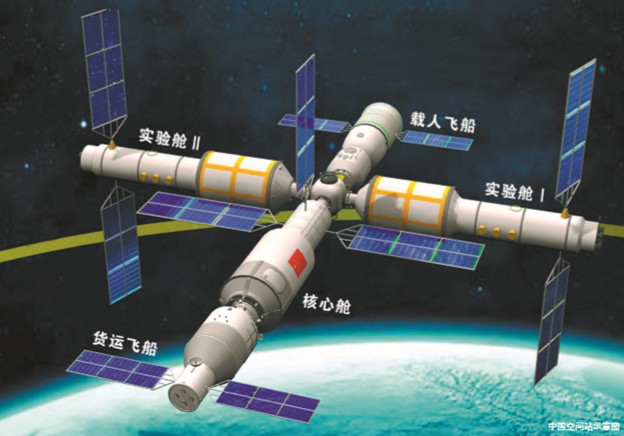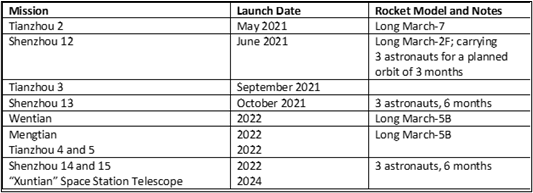By: Elizabeth Chen
Image: The launch of a Long March 5B Y2 rocket carrying the Tianhe module that will become the core of the China Space Station, on April 29 from Wenchang Launch Site in Hainan Province. Once completed in 2022, it will be China’s first long-term space station. After 2024, it may be the only international space station in orbit (Image source: Xinhua).
On April 29, a Long March 5B (长征五号B, Changzheng wuhao B) heavy rocket carrying the Tianhe 1 (天和一号) core module of China’s space station was successfully launched into low earth orbit from the Wenchang Spacecraft Launch Site, Hainan Province (Xinhua, April 29). It marks the first step in the construction of the China Space Station (CSS, 中国空间站, Zhongguo kongjian zhan), long seen as the culmination of a national manned spaceflight program that will aid in “realizing the shared vision of a community of destiny for the benefit of all mankind” in international space cooperation (People’s Daily, June 20, 2019).
China took a 30-year-long route toward developing an indigenous space station. Smaller “space laboratories” (空间实验室, kongjian shiyan shi) with shorter lifespans were launched in September 2011 (Tiangong 1 (天宫一号), 8.5 tons) and September 2016 (Tiangong 2, 8.2 tons), which provided important lessons about cargo transportation, on-orbit fuel resupply and life support (Xinhua, September 17, 2016).[1] Following the launch failure of a Long March 5 rocket in 2017, the core module launch was delayed by three years (GBtimes.com, March 5, 2018).
Tianhe 1 was developed by the China Academy of Space Technology (CAST, 中国空间技术研究院, Zhongguo kongjian jishu yanjiu yuan), which is subordinate to the state-owned China Aerospace Science and Technology Corporation (CASC, 中国航天科技集团公司, Zhongguo hangtian keji jituan gongsi). It weighs 22.5 tons and includes components for space station command and control and life support. One Chinese hobbyist report took pains to note that its components are vastly more advanced than what is used on the ISS (36kr, April 29), which was launched in 1998.
The successful construction of a “long-term” and “large scale” Chinese space station is the third and final step of a “three step” development program for manned spaceflight (Project 921) that was laid out by the Politburo Standing Committee in 1992. Plans for the CSS were approved in September 2010 (UNOOSA, June 2016). After its anticipated completion in 2022, it will have a planned service life of more than 10 years and a mass of 60-80 tons; it will be less than a quarter of the size of the International Space Station (ISS), which has a mass of around 420 tons.
Next Steps
According to the long-time China space watcher Andrew Jones, China plans a “high-density, highly challenging launch cadence with complex equipment and operations” completing 11 CSS-related launches over the course of 2021 and 2022 (Andrew Jones via Twitter, April 28). These will include the launch of two experimental models named Wentian (问天) and Mengtian (梦天), which will connect to Tianhe 1 to form a “t-shaped” space station, as well as four cargo shipments and four manned launches (People’s Daily, January 14). The first cargo spacecraft Tianzhou 2 (天舟二号) will launch from Wenchang, Hainan in May, and the Shenzhou 12 (神州十二号) manned spacecraft will launch from Jiuquan, Gansu in June (163.com, April 30; The Paper, April 29). A space station telescope named Xuntian (巡天) that is expected to be 300 times larger than NASA’s Hubble Telescope has a planned launch in 2024 and will be capable of docking with the CSS (Sixth Tone, April 29; Ccdi.gov.cn, March 29). Image: An artistic rendering of the complete China Space Station that shows two “experimental modules” and a core module in the center. Source: Csaspace.org.cn).
Image: An artistic rendering of the complete China Space Station that shows two “experimental modules” and a core module in the center. Source: Csaspace.org.cn). Table: Planned cargo supply and manned launches related to CSS over the next two years. (Sources: The Paper and Andrew Jones via Twitter).
Table: Planned cargo supply and manned launches related to CSS over the next two years. (Sources: The Paper and Andrew Jones via Twitter).
 Image: An artistic rendering of the complete China Space Station that shows two “experimental modules” and a core module in the center. Source: Csaspace.org.cn).
Image: An artistic rendering of the complete China Space Station that shows two “experimental modules” and a core module in the center. Source: Csaspace.org.cn). Table: Planned cargo supply and manned launches related to CSS over the next two years. (Sources: The Paper and Andrew Jones via Twitter).
Table: Planned cargo supply and manned launches related to CSS over the next two years. (Sources: The Paper and Andrew Jones via Twitter).The Need for a Chinese Space Station
China has been banned from accessing the ISS since the U.S. National Aeronautics and Space Administration (NASA) decided to exclude it from international space cooperation activities in 2011, largely due to concerns about technology theft and national security. The CSS would allow China to conduct sustained scientific research in space, as well as giving it a leading edge in cooperation with other existing and emerging national space programs. In 2016, China signed an agreement with the United Nations Office for Outer Space Affairs (UNOOSA) to open the CSS to all UN member states, in addition to various other bilateral space cooperation agreements (State Council, December 27, 2016). Since then, China has widely touted its commitment to peaceful “space cooperation and the community of shared future for mankind” (Xinhua, March 28, 2018). In implicit contrast to other exclusionary space powers (i.e., the U.S.), China has said that the CSS “welcomes all nations of the world to join” (Chinanews.com, May 4). Notably, no U.S. projects were selected for the first nine scientific experiments scheduled to take place on the CSS, which will involve 17 countries with a wide range of spacefaring experience (Space News, June 13, 2019).[2]
As already mentioned, China has sought an independent space station since long before it was excluded from the ISS. Following the Tianhe 1 launch, People’s Daily published a congratulatory message from Chinese Communist Party (CCP) General Secretary Xi Jinping which said that “building a space station and national space laboratory is an important goal…of China’s manned space program” and harkened back to the Mao-era “two bombs one satellite” (两弹一星, liangdan yixing) strategy that emphasized self-reliance and innovation (People’s Daily, April 30)—two national competition themes which remain in vogue today amid Xi’s increasing push for technological and economic decoupling. Xi’s message was a reminder that Chinese space programs have always been closely tied to issues of national security and global prestige. A 2016 white paper called for China to become “a space power in all respects” by the middle of the century, tying this goal directly to Xi’s larger ambition to achieve the “China Dream” of “national rejuvenation” by 2049 (State Council, December 27, 2016).
Alongside the Beidou (北斗) satellite navigation system and the associated Belt and Road Space Information Corridor (“一带一路“ 空间信息走廊, “yidai yilv” kongjian xinxi zoulang); the Mozi (墨子) quantum satellite; the Chang’e (嫦娥) lunar program and the Tianwen (天问) Mars missions, the Tiangong space station symbolizes that China is becoming a “space power” (航天强国, hangtian qiangguo) (CCTV, April 24, 2020).
Growing Governing Influence as a Space Power
A 2020 joint study by the China Aerospace Studies Institute (CASI) and the Center for Naval Analyses (CNA) concluded that China has consistently pushed a narrative—aided in large part by its construction and promotion of the CSS—that it will be “a more inclusive space power” than the U.S. and that it stands as a proponent for peaceful cooperation in space, while simultaneously minimizing security aspects of its space program. China likely wishes to shape international debates on “space arms control, space sustainability, the commercial uses of space, and natural resource extraction,”[3] in addition to sidelining stricter international norms against anti-satellite (ASAT) and counterspace activities, which it continues to pursue (Lawfare, January 28). As more countries become involved in space activities (potentially aided by access to the CSS), China will have greater opportunities to expand its influence in space governance by “courting developing nations and proactively interacting with the United Nations.”[4] According to the independent analyst Namrata Goswami, a permanent space station “signals to the world that China is openly contesting the United States for space leadership across the board, and that it is a capable partner for international cooperation in space” (The Diplomat, May 1).
Conclusion
It seems as though a new era of space cooperation (or competition) could be on the horizon. The international agreements currently governing the joint operation of the ISS will expire in 2024, and Russia recently announced that it plans to formally withdraw from the ISS after that and will seek to build its own space station (Moscow Times, April 19). India has also expressed interest in building an independent space station (June 13, 2019). Both of these countries have signaled their desire to join the CSS. Meanwhile, U.S. policymakers have grown increasingly concerned about plans to safely deorbit the ISS at the end of its lifetime, which is expected to be sometime after 2028 (Space.com, November 2, 2020). Chinese onlookers have rather cynically pegged the ISS’s endpoint to 2024, at which point the CSS could be the only international space station in low earth orbit, making China—by at least one metric—the de facto global leader in space (The Paper, May 4).
Yet China’s ability and willingness to be a responsible leader remains questionable. To give just one space-related example, it has been criticized for its failure to ameliorate excess debris. As of the time of writing, the U.S. Space Command is closely tracking the return to earth of the Long March 5B that launched Tianhe 1, and a White House press briefing criticized China’s continued failure to control the descent of its rocket launches (White House, May 5). The Long March 5B’s large size and uncontrolled re-entry has prompted concerns that large pieces of debris could fail to burn up in the atmosphere. While it is statistically unlikely that such falling debris would be dangerous to humans (as opposed to falling in the ocean), debris from the uncontrolled re-entry of China’s first Long March 5B launch hit two villages in the Cote d’Ivoire last May (SCMP, May 14, 2020). When asked for comment about such concerns, a foreign ministry spokesperson replied unsatisfyingly that China “is always committed to the peaceful use of outer space and stands for international cooperation in this regard” (PRC Foreign Ministry, May 6).
Elizabeth Chen is the editor of China Brief. For any comments, queries, or submissions, feel free to reach out to her at: cbeditor@jamestown.org.
No comments:
Post a Comment